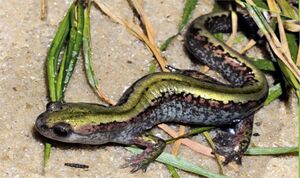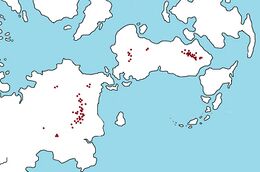Rimala
| Crevice Salamanders | |
|---|---|

| |
| Rimala exusitus | |
| Scientific classification | |
| Kingdom: | Animalia
|
| Phylum: | Chordata
|
| Class: | Amphibia
|
| Order: | Caudata
|
| Family: | Rimalidae
|
| Genus: | Rima
|

| |
| Occurrences of extant Rimala in Ameríca Libré | |
Rimala is a genus of lungless salamanders, the sole member of the family Rimalidae. The common name for the genus Crevice Salamanders, while some species are referred to as Shale Salamanders for their biology & habitat choice. Herpetologists often refer to all species in the genus with respect to the family name, Rimalids.
These salamanders are endemic to a few select valleys and mountain stream systems across eastern Ameríca Libré. They are also unique in both life history and taxonomy, making them a critical feature of endemic biodiversity in the region.
Biology
Life History
Salamanders of this genus & family are unique in that while adults share a single form (semi-terrestrial morph), the juveniles have two different forms. Water levels affect epigenetic expression while in the egg phase. If the eggs are submerged within the first few days of being laid, they will quickly hatch into gilled, paddle-tailed larvae. If the eggs remain unsubmerged, the larvae will undergo two to four weeks (longer in some species, such as R. albaraccina) before hatching into a gill-less, long-tailed larvae with thicker legs. The sexually immature metamorphs of the aquatic morph larvae have smaller, fatter tails and skinnier legs while the metamorphs of the terrestrial larvae resemble smaller adults. By the time of sexual maturity, the adult form of both morphs will be completely indistinguishable from one another.
They feed primarily upon crustaceans and annelid worms that live in waterfalls and wet soils.
Habitats
As their name suggests, Rimala are found in rocky areas with thin, deep crevices - primarily shale deposits. Alkaline environments (soil & water) are also a necessity, as they are adapted to the higher pH levels present in shale springs (and calcium-heavy rocks). Because of this, virtually all species are vulnerable to acid rain.
High levels of moisture - even without standing water - are necessary for both juveniles and adults. Like most Plethodontid salamanders, Rimalidae respire through their skin, and drying skin can directly impair respiration and cause immense stress. Typical habitats inhabited by this species include waterfalls and springs where moisture seeps through the rocks. Some species can also be found in caves.
Taxonomy & Evolution
Distribution Theories
Cordillera Bridge Theory
Juarez Lowland Bridge Theory
A separate theory, proposed by Humbert & De Salino (2014), suggests that the basal ancestor of both extant and fossil-record Rimalidae was an Amphiuma-like aquatic species that occupied lowlands in what is now the Sea of Juarez. During prehistorical periods of high-glaciation and resulting lower average global sea levels, the Sea of Juarez was a low-laying river basin which drained off the northern slopes of the Sierra Polaches. Prior to the Inyurstan Obduction, the plate which the region resided on was also higher and more stable. Fossil records and carbon quantities in hardened specimens from the region also indicate that the area was wet enough to support dense plant life, implying it was likely either jungle or vast marshlands.
Humbert, De Salino and their contemporaries propose that such an ancestor would have crossed from the Neartic into the Neotropical through this region, but returned to a mostly terrestrial lifestyle when dispersing into the mountainous regions. However, their theory does not account for the almost exclusive presence of Rimalidae on south and west-facing geological slopes across Ameríca Libré, which implies that the...